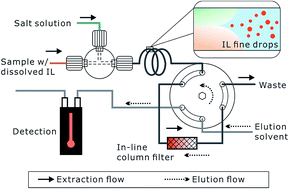Salt-induced ionic liquid dispersive liquid–liquid microextraction and filter separation
Abstract
In this paper, a novel on-line microextraction method based on new principles to generate and separate a dispersive extraction phase is introduced for sample enrichment from water prior to spectrophotometric determination. The dispersed droplets of N-octylpyridinium tetrafluoroborate ionic liquid in the sample were generated by adding sodium perchlorate and collected using regular syringe filters or in-line column filters. As the method is performed by simply mixing and injecting a solution, it eliminates the need for centrifugation, stirring, shaking, and so on. It is suitable for both a fast manual operation and on-line integration with automatic instruments. The time taken for manual extraction was less than two minutes. Reagent consumption is minimized because the typical organic to aqueous phase ratio is as low as 1 μL mL−1 whereas the extraction ratio for Sunset Yellow dyes is over 48%. Six common dyes were used as model compounds to demonstrate this method. The influences of salt concentration, extraction phase volume, filter capacity and elution volumes were studied. Finally, the on-line microextraction and continuous flow spectrophotometric detection system was built and tested. The sensitivities increased 6 to 13 times for different dyes. Commercial soft drinks were used as real samples. The detection limit reached 0.01 μg mL−1 for Sunset Yellow and recoveries ranged from 96% to 115%.


 Please wait while we load your content...
Please wait while we load your content...